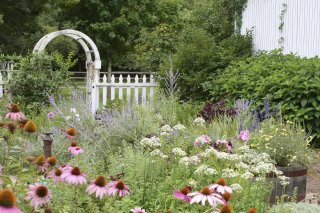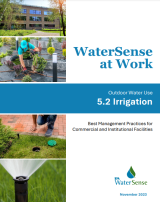Take Action

Once you understand your HOA’s water use, have found some allies, or funding, it’s time to act and start your project. There are many ways to achieve water-efficiency outdoors, the trick is to find the best combination of tools that work for your property’s needs. Water efficiency can look like anything from an irrigation retrofit to turfgrass conversion. This section will walk you through many of the resources WaterSense has to help put a plan for your outdoors spaces into action. Whatever choices are made, they should be rooted in reality and reflect your community’s values and priorities.
On this page:
- Tackle Water Efficiency at the Root
- Use WaterSense Irrigation Guides and Labeled Products
- Improve Pool Water Efficiency
- Work with Contractors
- Create a Master Plan
Tackle Water Efficiency at the Root
The story of water-efficiency starts in the ground. Healthy biodiverse soils hold onto water and yield healthy plants.

Healthy plants appropriate for your local climate and soil type have deep established roots increasing their resilience to extreme weather like drought or heavy storms. These are the building blocks of water-smart landscapes which are designed from the ground up. The water applied to these landscapes stay in the soil and is made available to plants, ultimately saving water. The design and layout of your landscape also plays a role in water efficiency. Eliminating slopes and grouping plants with similar watering needs can also help reduce water waste. The WaterSense Landscaping Tips web page can tell you more about how to create healthy, water-conscious landscapes. Be sure to also check out the WaterSense Water-Smart Landscapes Guide for more information on how to design the perfect landscape right for your needs and the What to Plant list to find low water-using plants for your region.
Once you’ve determined how to design or transform the most water-efficient landscape for your community’s common spaces, consider reviewing your HOA requirements or covenants for homeowner landscapes, if you have them, so homeowners have the flexibility to choose a native water-conscious landscape.
For additional WaterSense resources on landscaping explore the following:
- WaterSense at Work, Best Management Practices for Commercial and Institutional Facilities, Section 5.1 Landscaping
- Technical Reference Manual for WaterSense Labeled Homes:
- Landscape Design and Plant Selection Tech Sheet
- Soil Management and Mulching Tech Sheet
- WaterSense’s Turfgrass and Water Efficiency web page
- Water Efficiency Management Guide Landscaping and Irrigation
- WaterSense’s Landscape Photo Gallery
Use WaterSense Irrigation Guides and Labeled Products
Designing and planting the right plants in the right place is only half the equation when it comes to water efficiency outdoors. Plants after all are living things, they require maintenance and the proper equipment to ensure they thrive. Ideally, landscapes won’t need any irrigation apart from natural rainfall, but during long, hot summer months, prolonged drought, or root establishment they might need a little help.

Experts estimate that as much as 50 percent of water used outdoors is wasted due to overwatering caused by inefficiencies in irrigation methods and systems. If installing irrigation makes sense for your landscape, or you’re looking to retrofit an existing system after an audit, WaterSense labeled products can lower your water use without sacrificing performance. WaterSense labeled irrigation controllers can significantly reduce overwatering by applying water only when plants need it, and spray sprinkler bodies regulate pressure to efficiently apply water to the landscape. Find these and other WaterSense labeled products with our Product Search Tool. Be sure to explore funding opportunities like product rebates as described on the Find an Ally section of the Get Started web page.
WaterSense also developed best management practices and other guides to help address water-efficient irrigation systems, going beyond products alone. Learn more about irrigation products and practices to find the balance right for your HOA below:
- WaterSense at Work, Best Management Practices for Commercial and Institutional Facilities, Section 5.2 Irrigation
- WaterSense’s Microirrigation web page
- Technical Reference Manual for WaterSense Labeled Homes
- Spray Irrigation Tech Sheet
- Microirrigation Tech Sheet
- Irrigation Controllers Tech Sheet
- Rain Sensors Tech Sheet
- WaterSense’s Fix a Leak Week web page
Improve Pool Water Efficiency
Look beyond your landscape when looking for outdoor water savings. You can also look to your community pools for water efficiency opportunities. To help mitigate water losses from pools, including evaporation from a pool’s water surface, WaterSense has developed guides on water efficiency practices for commercial and residential pools below:
- WaterSense at Work, Best Management Practices for Commercial and Institutional Facilities, Section 5.3 Commercial Pool and Spa Equipment
- WaterSense’s residential Pool Water Efficiency web page
Work with Contractors

After installing or updating the right combination of irrigation tools and plants in your landscape, your system and plants will require some attention to maintain their performance. Using water-efficient practices in your landscape is one of the most important ways HOAs can reduce water use and high water utility bills. Plants require trimming and watering especially during establishment and irrigation systems require proper scheduling and maintenance from normal wear under the elements. Maintaining a single landscape is a lot of work, let alone an entire property. It’s likely your HOA already has a relationship with contractors to manage your outdoors spaces.
It is important to have the right people on your team and communicate regularly with your contractors about the management of your outdoor spaces. WaterSense developed Sample Water-Efficient Landscape and Irrigation Contract Language (pdf) HOAs can consider incorporating when renewing existing landscape and irrigation contracts or negotiating new ones to ensure water efficiency is the top priority during the next watering season. Work with your contractors to set expectations about aesthetics, water efficiency, and other priorities so the people managing your landscape and irrigation system can help meet your HOA’s goals. If you have multiple contractors, a property management company, and/or other groups helping with your work, be sure to identify each party’s role and clearly communicate the expectations of each party.
If you are looking to hire a contractor, look for irrigation professionals certified by a WaterSense labeled irrigation program. Certified irrigation professionals have skills and knowledge to help you improve the health and water efficiency of your HOA’s landscape. Find a certified irrigation professional using WaterSense’s Find a Pro tool. To learn more about what certified irrigation professionals can do for your HOA and questions you should be ready to ask them, visit our Irrigation with a Pro web page.
Remember that hiring the right contractor (with water management credentials and mindset) may not mean accepting the lowest bid; however, increasing oversight of a landscape irrigation system will often reduce water use and associated water utility costs.
Create a Master Plan
If your HOA has a lot of actions you want to tackle, consider developing a master plan for your community’s landscape and irrigation system, assigning a budget for maintenance and future enhancements each year while defining what you plan to tackle. The master plan can be passed down when there is Board turnover to keep your HOA on track to save water and utility costs.
Jumpstart Your Outdoor Water Savings
If a master plan sounds overwhelming, start at the beginning and consider taking on these three simple tasks to jumpstart your water savings.
- Make sure you aren’t watering the pavement. Do a walk through of your irrigation system and re-direct spray heads that are spraying onto pavement or other hardscapes.
- Adjust your irrigation schedule based on the season and don’t water when it’s already wet. Install a rain sensor to stop irrigation during rain events, and consider installing a WaterSense labeled irrigation controller to help best manage your watering based on weather and soil conditions.
- Identify big spikes in water use by evaluating your water bills or tapping into your smart irrigation meter, if installed. Find and fix leaks immediately.
